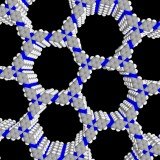Let there be hydrogen
An organic framework serves as a catalyst for the photocatalytic conversion of water into hydrogen
Humanity’s need for energy is ever-increasing. However, the traditional energy sources are finite. In contrast, water and sunlight are available in vast abundance. Scientists at the Max Planck Institute for Solid State Research in Stuttgart and from LMU Munich have now created a material that uses light to produce the versatile energy source hydrogen from water. This polymeric photocatalyst is chemically stable. Moreover, the rate of hydrogen production can be fine-tuned by means of small structural modifications of the catalyst.

Organic frameworks (COFs) can produce hydrogen. The model for the COF structure is colour-coded: blue denotes nitrogen, grey carbon, and white hydrogen.
Finding a photocatalyst capable of splitting water is not an easy task. What is needed is a substance that directly uses the energy of sunlight to split the hydrogen-oxygen bonds in water. In laboratories, this has been achieved with certain substances; however, the yield is often low and everyday industrial use is still a long way off.
Bettina Lotsch’s Nanochemistry Research Group at the Max Planck Institute for Solid State Research in Stuttgart and at Ludwig-Maximilians-Universität München (LMU), together with theoreticians working with Christian Ochsenfeld at LMU, has developed a new approach. The scientists have created so-called COFs, covalent organic frameworks, which can produce hydrogen.
COFs are highly crystalline, porous polymers in which certain parent molecules form highly regular, two- or three-dimensional network structures. These network polymers possess suitable optical and electronic properties, as well as a relatively large surface area, which in essence make them interesting candidates for photocatalytic hydrogen evolution.
Even more important is the molecular precision with which such photocatalysts can be devised and optimized. COFs are therefore a useful platform for adapting material properties and, thus, rationally controlling the photocatalysis process.
Migrating charge carriers
Photocatalysts must contain charge carriers that can be excited using visible light so that they can move relatively freely and be transferred to a different atom or molecule. Ultimately, it is these electrons which are transferred to the protons in the water molecule - and thereby create elementary hydrogen.
The COFs created in Stuttgart meet all the prerequisites. However, the scientists had to add platinum nanoparticles and an electron donor to their powder polymer. “The platinum nanoparticles work as microelectrodes on which the electrons are transferred from the COF to the protons to form hydrogen”, says Vijay Vyas, a scientist in the Nanochemistry Research Group at the Stuttgart-based Max Planck Institute for Solid State Research.
“And the electron donor is necessary to remove the residual positive charge on the COF”, Vyas explains. The scientists added all the ingredients to an aqueous solution. When irradiated with visible light, the mixture starts producing hydrogen.
The scientists were not only thrilled that the thus formed COFs were able to produce hydrogen; they further managed to regulate the rate with which the material generated hydrogen by fine-tuning the molecular geometry of the building blocks and, hence, of the networks.
To do this, they adapted the precursor material – a triphenylarene compound – which they used to make the photocatalyst. “We achieved a particularly high hydrogen yield when the precursor compound was almost planar”, Vyas says. The finding coincided with theoretical calculations carried out in parallel. “This is the first time ever that we are able to tune the photocatalytic properties of a COF precisely at the molecular level”, says the Max Planck scientist.
In the future, the researchers want to use the findings to develop their substances further in a targeted manner. One goal is to gain a better understanding of the photocatalytic mechanism in these systems and to be able to hone the complex interaction of the individual components.
From the lab bench to practical applications
Despite the early success, these materials are still far from being considered for industrial hydrogen generation using water and sunlight. For instance, the material needs to be prepared cost-efficiently in larger quantities in order to generate hydrogen steadily over long periods. Despite these and further issues to be addressed, Vijay Vyas deems it very probable that humankind will one day be able to produce hydrogen efficiently using light, water and a simple carbon-based material.
Hydrogen obtained in such an environmentally friendly way could be used in many different applications. Already envisaged scenarios include its use as fuel for vehicles or for producing carbon-based energy carriers. In fuel cells, electricity could be generated using hydrogen (and oxygen). Hydrogen which is currently used in the industry to manufacture many important chemicals could also be made available in a more sustainable fashion. Currently, it is largely obtained using fossil raw materials.
PH/KH
